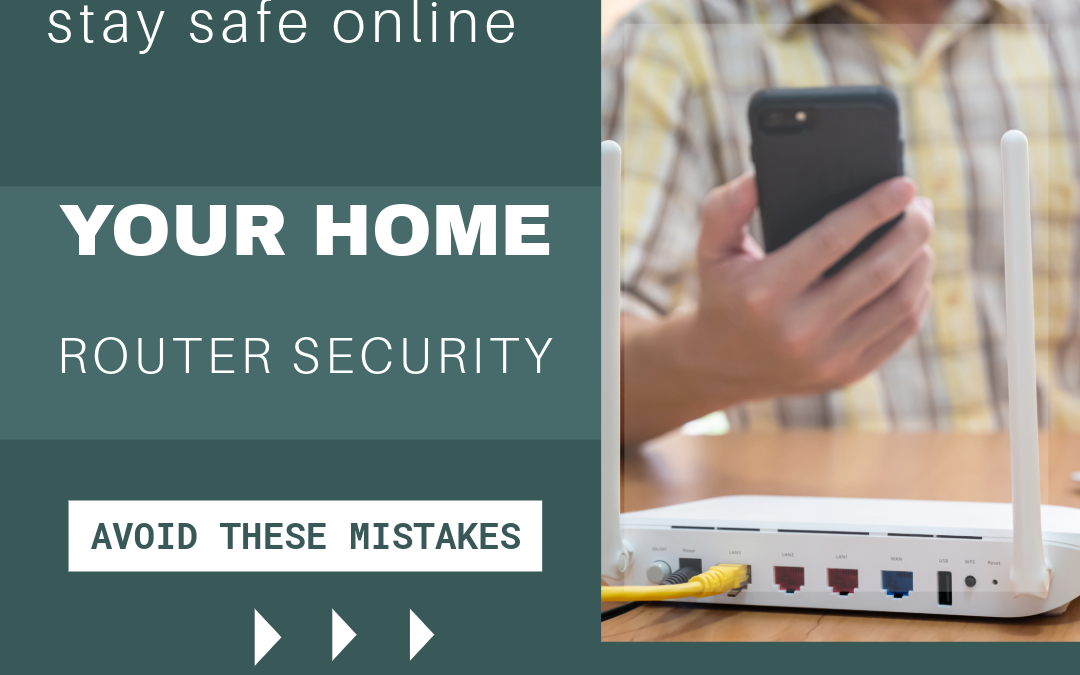 5 Router Security Mistakes You Didn’t Know You Were Making
5 Router Security Mistakes You Didn’t Know You Were Making
Default passwords, exposed ports, and other common fails could be exposing your family
Your home router is the digital gateway to your family’s online life. Every device that connects to your Wi-Fi—from smartphones and laptops to smart TVs and security cameras—depends on your router for internet access. Yet most people set up their Wi-Fi routers once and forget about them, unknowingly leaving their entire Wi-Fi network vulnerable to cyber threats.
The reality is sobering: cybercriminals are constantly scanning for poorly secured home networks, and the consequences of a security breach can be devastating, leading to unauthorized access. From identity theft and financial fraud to privacy violations and compromised smart home devices, the risks are real and growing, highlighting the need for robust security patches.
The good news? Most common mistakes related to router security are easily preventable once you know what to look for. Here are five critical mistakes that could be putting your family at risk—and how to fix them today.
1. Keeping Default Login Credentials
The Mistake: Using the factory-set username and password to access your router’s admin panel.
Most routers ship with generic login credentials like “admin/admin” or “admin/password.” These default combinations are public knowledge—they’re printed in user manuals, posted on manufacturer websites, and compiled in databases that hackers regularly consult.
When you keep these default credentials, you’re essentially leaving your front door wide open. Anyone who gains access to your network (including neighbors who crack your Wi-Fi password) can log into your router’s configuration panel and wreak havoc.
What Attackers Can Do:
- Change your Wi-Fi password and lock you out of your own network
- Redirect your internet traffic through malicious servers
- Install malware that affects all connected devices
- Access and modify your network settings
- Monitor your internet activity
The Fix: Log into your router’s admin panel immediately and change both the username and password. Create a strong, unique combination that includes uppercase and lowercase letters, numbers, and special characters. Store these credentials securely—you’ll need them for future configuration changes.
2. Leaving Unnecessary Services Running
The Mistake: Failing to disable unused network services and protocols.
Modern routers come packed with features, many of which remain enabled by default even if you never use them. Services like WPS (Wi-Fi Protected Setup), remote management, UPnP (Universal Plug and Play), and guest networks can all create potential entry points for attackers.
Each enabled service represents another door that hackers can try to force open. Even legitimate features can become security risks when they’re poorly implemented or left unconfigured.
Hidden Dangers:
- WPS: Despite its convenience, WPS has known vulnerabilities that allow brute-force attacks
- Remote Management: Enables router access from anywhere on the internet—including by hackers
- UPnP: Automatically opens ports for devices, potentially exposing internal services
- Unused Guest Wi-Fi Networks: Can provide an easier target for initial network access
The Fix: Audit your router’s enabled services and disable anything you don’t actively use. Turn off WPS if you don’t need one-button device connections to enhance your home router security. Disable remote management unless you specifically need to access your router from outside your home. Review UPnP settings and consider disabling it if you don’t have devices that require automatic port forwarding.
3. Running Outdated Firmware
The Mistake: Never updating your router’s firmware after initial setup.
Router manufacturers regularly release firmware updates that patch security vulnerabilities, fix bugs, and improve performance, so ensure you stay updated with your router’s manufacturer. However, unlike your smartphone or computer, routers don’t typically update themselves automatically—and many users never think to check for updates manually.
Running outdated firmware is like driving a car with known brake problems. You might be fine for a while, but eventually, that vulnerability will be exploited.
The Growing Risk: Cybersecurity researchers constantly discover new router vulnerabilities. When these flaws become public knowledge, hackers quickly develop tools to exploit them. If your router is running old firmware, you’re essentially advertising these vulnerabilities to anyone scanning your network.
The Fix: Check your router manufacturer’s website for firmware updates at least quarterly. Many newer routers offer automatic update options—enable this feature if available to ensure you receive the latest security patches. When updating firmware, always download directly from the manufacturer’s official website to avoid malicious versions.
Set a calendar reminder to check for updates every three months. The few minutes this takes could save you from becoming a victim of the latest router exploit.
4. Using Weak Wi-Fi Encryption
The Mistake: Sticking with outdated encryption protocols or weak password schemes.
Your Wi-Fi encryption is the lock on your wireless network. Yet many routers still default to older, less secure encryption methods, and users often choose Wi-Fi passwords that are trivially easy to crack, compromising their access point.
If you’re still using WEP encryption (largely broken since 2005) or even WPA/WPA2 with a weak password, determined attackers can hijack your network in minutes rather than months.
Encryption Reality Check:
- WEP: Completely broken and crackable in under 10 minutes
- WPA/WPA2/WPA3 with weak passwords: Vulnerable to dictionary attacks
- WPS-enabled networks: Can be brute-forced regardless of password strength
- Open networks: Offer zero protection against eavesdropping
The Fix: Use WPA3 encryption if your router supports it, or WPA2 as a minimum standard. Create a Wi-Fi password that’s at least 15 characters long and includes a mix of letters, numbers, and symbols to safeguard your network name (SSID). Consider using a passphrase made of random words—it’s both secure and easier to remember than complex character strings.
Avoid common password patterns like “Password123” or your address plus the current year. Hackers specifically target these predictable combinations.
5. Ignoring Port Security
The Mistake: Leaving unnecessary ports open or misconfiguring port forwarding rules.
Ports are like windows and doors in your network’s security perimeter. Every open port is a potential entry point, and poorly configured port forwarding can expose internal devices directly to internet-based attacks.
Many users set up port forwarding for gaming consoles, security cameras, or remote access tools but forget to review these rules over time. What seemed like a temporary configuration can become a permanent security hole, potentially leading to unauthorized access.
Port-Related Risks:
- Unnecessary open ports: Provide attack vectors for malicious traffic
- Overly broad port forwarding: Can expose internal devices to direct internet attacks
- Forgotten forwarding rules: Continue operating long after the original need disappears
- Default service ports: Easier for attackers to identify and target
The Fix: Regularly audit your router’s port forwarding rules and firewall settings. Remove any forwarding rules you no longer need, and ensure that remaining rules are as specific as possible—forward only the exact ports required and restrict access to specific IP addresses when possible.
Consider using a VPN for remote access instead of opening ports directly. This provides encrypted access without exposing internal services to the broader internet.
Taking Action: Your Security Checklist
Router security isn’t a one-time setup—it’s an ongoing responsibility. Use this checklist to secure your network today and maintain its protection over time by implementing strong security features.
Immediate Actions:
Change default username and password
Update router firmware to the latest version
Review and disable unnecessary services
Upgrade to WPA3 or strong WPA2 encryption
Audit and clean up port forwarding rules
Ongoing Maintenance:
Check for firmware updates quarterly
Review network settings annually
Monitor connected devices for suspicious activity
Consider upgrading older routers that no longer receive security updates
Advanced Protection:
Enable automatic security updates if available
Set up network monitoring and logging
Consider implementing network segmentation for IoT devices
Use a guest network for visitors and untrusted devices
Your Network, Your Responsibility
In today’s connected world, your home wi-fi router is more than just a box that provides internet access—it’s the foundation of your family’s digital security. The five mistakes outlined above are common, but they’re also completely preventable with the right knowledge and a commitment to good security practices.
Don’t wait for a security incident to take router protection seriously. Spend an hour this weekend reviewing your router’s configuration, and make these wi-fi security improvements a regular part of your digital hygiene routine.
Your family’s online safety depends on the security decisions you make today. Make them count.
Common Router Security Mistakes to Avoid
Securing your home network is crucial to prevent unauthorized access and protect your sensitive information. Many users make common router security mistakes that leave their networks vulnerable to cybercriminals. Here are some key mistakes to watch out for:
- Using Default Username and Password: Many routers come with a default username and password, which are often printed on the router. Changing these is one of the simplest yet most effective security measures.
- Neglecting Firmware Updates: Regularly updating your router’s firmware is essential to patch known vulnerabilities. Router manufacturers release security updates to fix exploits; failing to apply these updates can leave your network exposed.
- Insecure Wi-Fi Settings: Using outdated security protocols like WEP or keeping the default SSID can make your Wi-Fi network an easy target. Always opt for WPA2 or WPA3 encryption for better security.
- Not Setting Up a Guest Network: If guests need internet access, set up a guest Wi-Fi network. This keeps your primary network secure and limits access to your home devices.
- Ignoring Physical Security: Ensure your router is placed in a secure location to prevent tampering or unauthorized access.
To help you enhance your router’s security, consider investing in a quality router with robust security features. FlashRouters offers a range of secure routers designed to keep your home Wi-Fi network safe from vulnerabilities. Their products come with advanced security settings and regular firmware updates to ensure your network remains protected.
For further reading, check out these additional resources from FlashRouters:
By addressing these common router security mistakes, you can significantly improve the security of your home network and protect against potential security breaches.






